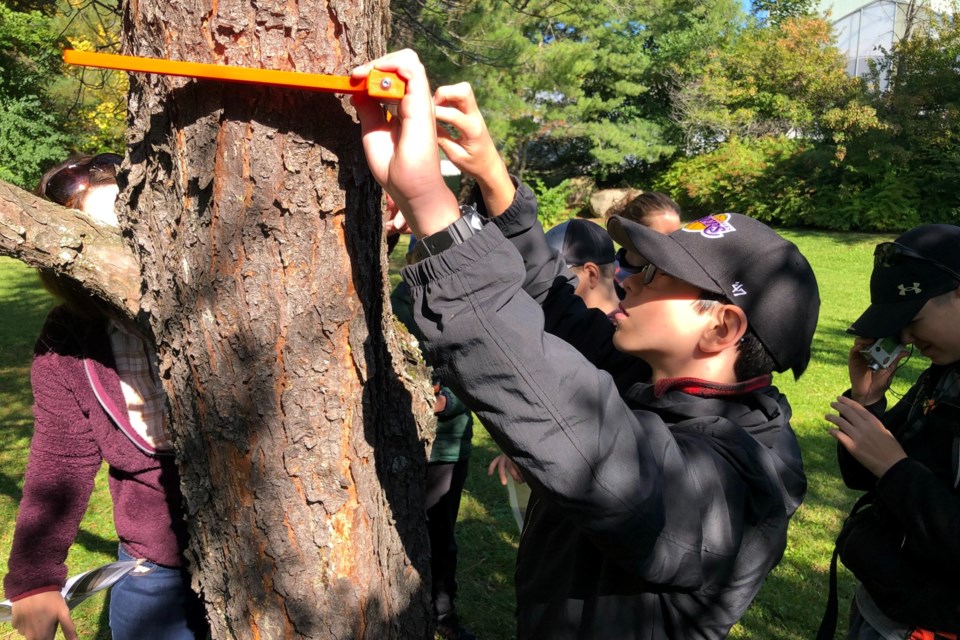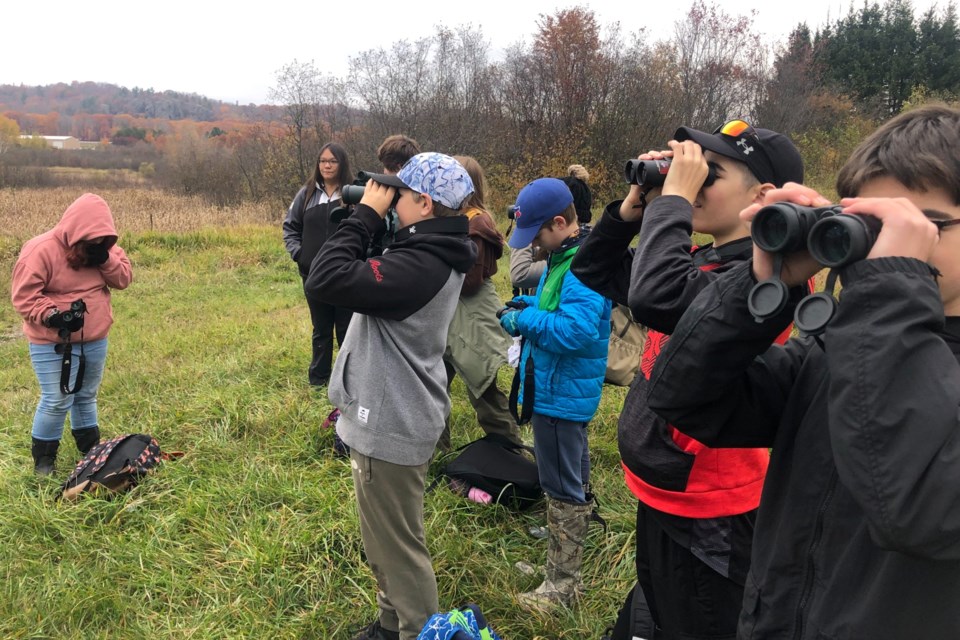A land-based learning teacher at White Pines believes something special is happening at her school.
Nancy Neave is wrapping up the first year of their Outdoor Learning Program — a fully integrated curriculum for Grade 7/8 students that places a focus on the outdoors, experiential learning, and Indigenous Ways of Knowing.
A first-of-its-kind initiative in the Algoma District School Board, the program provides intermediate students with learning opportunities they wouldn’t otherwise have in a traditional classroom setting.
In fact, much of their time is spent away from the indoors.

“There are two outdoor spaces we can use,” Neave explained. “There’s one set up like a traditional classroom — stumps and desks and rock area. Then we have a forest nearby where we do a lot of our science curriculum. Phys-ed is also all outside.”
“It’s really important for students to have access to the environment,” she added. “Because we’re in a bit of an environmental crisis, one of our main themes and focuses is getting kids reconnected with nature so they’ll take on more of a stewardship role.”
But their learning isn’t just limited to the property surrounding White Pines.
The program provides students with the opportunity to travel on many more field trips where they get to visualize what they’re learning while absorbing information directly from local experts.
Whether they’re visiting outdoor green spaces, spending time at the art gallery, or making cultural connections with the Métis Council and Batchewana and Garden River First Nations, Neave believes it’s that kind of hands-on learning that will bode well for students looking to take their education to the next level.

“We’re out on field trips as much as possible,” she said. “The students are really happy and engaged when we’re out there. The children have done a really great job with their reflections and recognizing the learning that took place.”
The program began as a pilot project in the second term last year when Neave brought in some intermediate students who were already enrolled at White Pines.
Because of its success, the outdoor learning initiative made its official debut in September 2023 as 12 students came from all over the board and were transferred to the school to be part of the project.
Nine months later, Neave couldn’t have asked for a better first year.
“It went spectacular,” she said. “A lot of the students came out of their shells and really started to discuss, debate, and reflect. I think we have a really good group of kids who are connected to nature, the environment, and are re-engaged in school.”
While the program has notable differences from a typical course load, Neave assured there’s still plenty of time set out for mathematics, writing, and all the other standardized learning that’s expected of the general 7/8 curriculum.
“We’re still working — it’s not all play,” she said. “The lessons are just so much more engaging because we have the field trips and the outdoor piece to it, but the curriculum is still being taught.”
Outdoor learning students Colton McComb and Sylas Kahtava told SooToday they feel they learn best when working hands-on and in the outdoors, both of which were drawing factors to attend White Pines this year.

“We did a photography unit where we got a professional photographer to come in and show us how to properly take pictures,” McComb recounted. “It was really fun because we went on three different field trips to take pictures, and then we had a show. It was great.”
“I loved the experience in Pancake Bay because I never went before and I learned a lot about it,” Kahtava added. “I find I’m more focused when I’m hands on and doing things. You also get to know everyone better since it’s not such a big group.”
Because they got to experience White Pines in an entirely different way this year, Grade 8 girls Eila Kuisma, Lillie Jones, and Hailey Dyni have all committed to staying at the school for Grade 9.
“Everything’s sticking more than it has at my previous school,” Jones said. “We learn the curriculum, but also learn a bunch about nature.”
“It makes for a much better learning environment,” Dyni added. “I think we’re all doing better in school. You can get actual experience in the woods and see and feel what you’re learning about.”
“I feel my grades are going up a lot more," Kuisma noted. “There’s less kids in the other classes, meaning the teacher gets to focus on you more.”
Heading into next year, Neave will be capping her class at 15 kids to ensure the ratio of instructor to students remains safe for the kinds of activities and out-of-classroom trips they partake in.
With enough support, she has long-term goals of eventually expanding the Outdoor Learning Program and building more partnerships with local organizations so more young people can immerse themselves in the environment.

“It would be great to have multiple classes here,” she said. “Maybe the potential to have a teacher who ran outdoor learning programs for other schools, but still based out of White Pines. That’s the way learning is going, and the Indigenous knowledge infused throughout the curriculum is really important.”
According to Neave, students interested in the sciences who love being outdoors but have a harder time sitting still would likely be very interested in the program.
She cautions parents that the kids will be expected to adapt to constantly shifting surroundings and last-minute changes to their scheduling.
“They have to be able to engage in a variety of circumstances, stay focused, and manage their own risk,” she said. “The child needs to have an intrinsic motivation to want to learn outside and learn in flexible learning settings because we’re changing all the time.”
“This is my passion, and I could not imagine a better job,” she added. “Environmentally, we try to do whatever we can to do our part. I love this work.”
